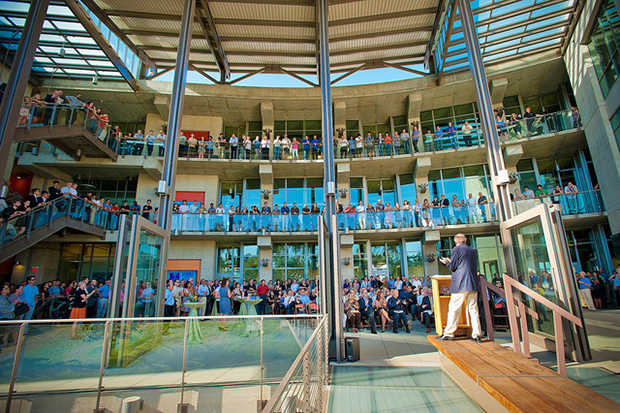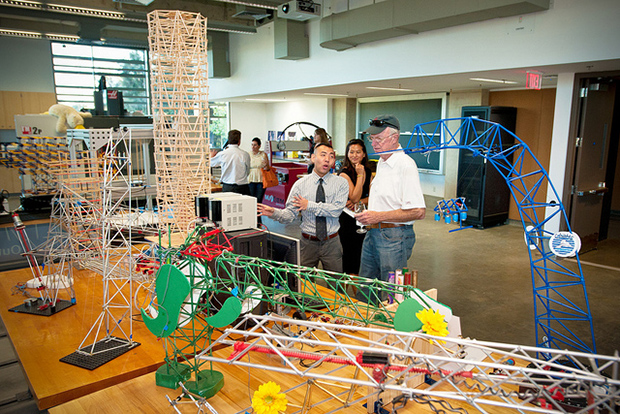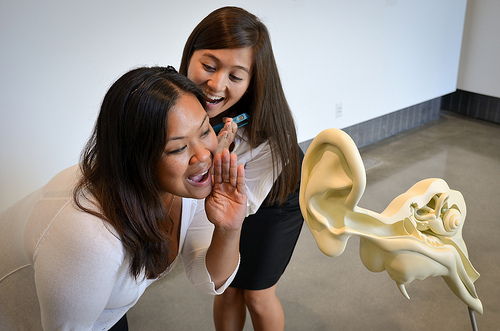By:
- Ioana Patringenaru
Published Date
By:
- Ioana Patringenaru
Share This:
New Structural and Materials Engineering Building Brings Visual Artists, Engineers Under One Roof to Solve Societal Problems

The new Structural and Materials Engineering building during a standing-room only ceremony.
Aerospace engineers and structural engineers are working together to make composite aircraft structures safer. Visual artists are using nanoengineering tools, such as a scanning electron microscope, to make art. Structural engineers and medical device researchers are joining forces to improve the design of a heart pump for children born with heart defects. These are only a few of the examples of multi-disciplinary work taking place in the new Structural and Materials Engineering building at the University of California, San Diego.
Campus officials dedicated the building Sept. 14 during a standing-room only ceremony. The event brought together the engineers, medical device researchers and visual artists who will work in the new facility, as well as top campus administrators, supporters and industry representatives.
The state-funded, 183,000-square-foot building provides the first permanent home for the departments of structural engineering and nanoengineering at the Jacobs School. These engineers share space with the department of visual arts, and with researchers from the Institute of Engineering in Medicine.
“These are the areas that define our future and the people who are working within these centers, within these departments, are future leaders,” said UC San Diego Chancellor Pradeep K. Khosla at the dedication. “As I look at where UCSD is headed, I think this building signifies the beginning of what we should be doing more and more of, which is combining sciences, engineering, technology, arts and humanities, all in a single hall to solve problems of societal significance.”
Frieder Seible, dean of the Jacobs School of Engineering at UC San Diego, echoed Khosla’s comments. “The hope and aspiration for this building is that it is not a physical location for four seemingly disparate academic units, but that it will be transformational for our campus and how we collaborate in our research and education mission,” he said.

Photo by Alan Decker/UC San Diego Publications
The building will offer educators a 21st-century space to teach 21st-century students, said Seth Lerer, dean of the Division of Arts and Humanities at UC San Diego. “I can think of no better bridge between the arts and sciences, between the imagination and technology than this structural and materials building and the remarkable collaboration that it offers all of us,” he said.
During the dedication, best-selling science fiction author and UC San Diego alumnus David Brin imagined some of the future discoveries engineers and artists will make by working hand-in-hand. Brin is particularly well suited for this exercise. He has won both the prestigious Nebula and Hugo awards for science fiction writing and also earned a Ph.D. in physics from UC San Diego in 1981.
“Problem solvers within these walls will send robots into the bloodstream and mysterious nonlinear realms within the cell,” he also said. “New work in fluidics, materials and battery storage will help us tackle vexing energy problems.” Researchers will create a world where truly smart materials will allow your shoes, your shirt, your dinner plate to actively respond to your will, Brin predicted.
The building also will help heal the divide described by philosopher C. P. Snow 50 years ago between the academic cultures of the hard sciences and the arts and humanities, he said. “This building will thrive because its cells are leaky, its structures malleable and adaptable to changing needs—deliberately almost biological,” Brin said.
The Structural and Materials Engineering building will be a place where students and faculty will be able to contribute to a better future and make a long-lasting impact, said Karl Beucke, president of the Bauhaus-University, Weimar, which partly inspired the “mixed-use” idea for the building.
State Assemblyman Nathan Fletcher predicted that the building would have a significant impact in San Diego and for the economy as a whole. He represents the 75th district, which includes UC San Diego. “The real treasure will be the students that come out this,” he said. “They’re going to build the jobs of the future. They’re going to solve a lot of amazing problems.”
The facility also is home to the Cymer Conference Center, which will help foster these collaborations, while supporting San Diego’s technology community.

Photo by Alex Matthews/Calit2
During the event, many guests stopped by the building’s art gallery, home to an art exhibit called “NanoMacroMega,” which will remain on view through Dec. 7 and features some of the UC San Diego arts/engineering projects already under development. These include artist Anya Gallaccio’s photographic prints made by using an electron microscope to scan nano- and micro- particles and Benjamin Bratton’s “Nanoskin” project, an examination of the geopolitical implications of nanoengineer Joseph Wang’s bioelectronics tattoos. Also on display in the gallery were computer simulations from the labs of Alison Marsden, a researcher in the medical devices group, and Yuri Bazilevs, a structural engineering professor. The simulations will be used to improve the design of the only FDA-approved cardiac pump for children born with heart defects.
The building will also support the interdisciplinary activities of the newly established Arthur C. Clarke Center for Human Imagination – directed by media artist Sheldon Brown and dedicated to harnessing the gift of imagination – and the Software Studies Initiative, directed by Lev Manovich, which was recently funded by the Mellon Foundation to build tools for the large-scale analysis of image collections. The new building will also support groups of scholars working on “design and geopolitics,” headed by Benjamin Bratton, and on “urban ecologies,” headed by architect Teddy Cruz, among others.
Many other guests stopped by Composite Aviation Safety Center, where two predator wings, a satellite antenna and the fuselage of a prototype jet were on display. The center will allow engineers to design and manufacture test specimens representing aircraft parts made from composite materials— for example, fuselage sections, landing gear and wings. These specimens can be outfitted with embedded sensors to detect damage and monitor their structural integrity while undergoing a wide range of tests, for example simulating the impact of everything from hailstones to baggage loaders. Finally, the data provided by the tests and sensors will be used to build models to predict damage and provide insights that will lead to improved designs. This cradle-to-grave approach is unique to the Jacobs School of Engineering at UC San Diego.
Share This:
Stay in the Know
Keep up with all the latest from UC San Diego. Subscribe to the newsletter today.



